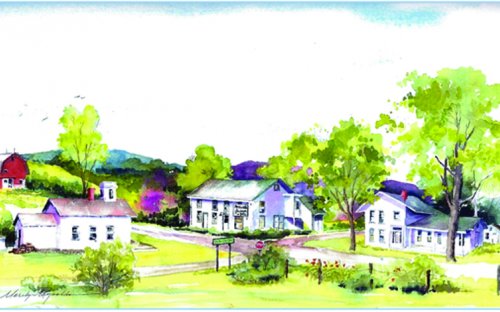Submitted by the Portville Historical and Preservation Society
The area known as Bedford Corners in the Town of Portville, New York, lies in the most southeastern corner of Cattaraugus County on State Route 305 where it intersects Deer Creek Road and Dodge Creek Road. The Deer Creek flows through Bedford Corners, adjacent and parallel to these two cross roads, passing under Route 305 and becoming Dodge Creek and eventually meeting the Allegheny River further down in the Village of Portville.
Portville was originally part of Lot 6, Town 1, Range 3, of the Holland Land Company's Survey. In 1856, Geils' Map of Cattaraugus County showed several structures at the corners, including a saw mill and grist mill as well as the residences of William Livingston and Israel P. Roberts. None of these older structures remain today. The house originally owned by William Livingston was located on or near the northeast corner but there is no physical evidence of its existence and remains an undeveloped hillside and grove of trees adjacent to the Allegany County line.
Jacob Bedford and his wife, Marilla, became the owners of the corners when they acquired land from one of the founding businessmen of Portville, Henry Dusenbury, in 1856 and 1858 as well as the lands of William Livingston in 1860. Bedford built his home at Bedford Corners for his family on the northwest corner soon after the acquisition in 1856.
In 1864, Jacob Bedford deeded land on the southeast corner to the Joint School District Number 7 for a new school house that came to be called The Bedford Corners School House. As early as 1845, the educational needs of the children located nearby in the towns of Little Genesee and Portville had been jointly served by a smaller school situated a short distance further north on Route 305 on the border of Cattaraugus and Allegany Counties. Jacob and Marilla, as well as their adult son, Ezra, were very active as trustees and oversaw the 1864 Bedford Corners school for many years.
Further expansion of the corner occurred in 1886 when the southwest corner was deeded to Jason Hopkins for the purpose of erecting a cheese factory. The Cheese Factory continued to operate until the early 1920s. In 1927, the property was conveyed to Portville Grange No. 842 where the local farmers and their families held meetings, seminars, square dances, and pot luck dinners.
As for the Bedfords, Marilla passed away in 1882. Jacob remarried Mary D. Wales who passed away in 1885. His third wife, Caroline Wales, Mary’s younger sister, survived Jacob, who passed away in June of 1904 at the age of 91. Caroline (Carrie) remained in the house with her brother, William Wales, until her death in the 1920’s when the house changed hands and the Eshelman family from Reading, PA, moved there.
The three Eshelman children grew up in the home but tragically, their father died in 1946. Sarah Eshelman remarried Harold Holcomb and moved up to the Holcomb farm up the Yuba Dam Road. Sarah’s daughter and granddaughter lived in the house for several years but it remained largely empty until Sarah’s son, Col. Charles O. Eshelman returned from the Army in 1975. He acquired the original Bedford house in 1981 and began to obtain more properties at the corners as well as vast acreage on the Yuba Dam Road.
Col. Eshelman acquired the other original Bedford properties, the Bedford Corners School House in 1965 and the Portville Grange in 1971. In 2001, Col. Eshelman deeded these two properties to the Portville Historical and Preservation Society in the hope that these properties would be preserved and developed into a community resource for educational and heritage tourism purposes. His many acres on Yuba Dam road were also transferred to the Pfeiffer Nature Center for similar purposes.
On May 20, 2003, the New York State Office of Parks, Recreation and Historic Preservation designated the properties as the Bedford Corners Historic District and listed it on the State Register of Historic Places. A ceremony was held on August 28, 2004, commemorating the event.
Since then, many repairs and renovations have occurred in all three buildings in anticipation of the society’s plan to open a museum complex in the near future. Ever since his passing in January of 2010 and subsequent bequest of the remaining property, PHPS has been fulfilling our promise to Col. Charles O. Eshelman to create his legacy for all to share his love of history.

